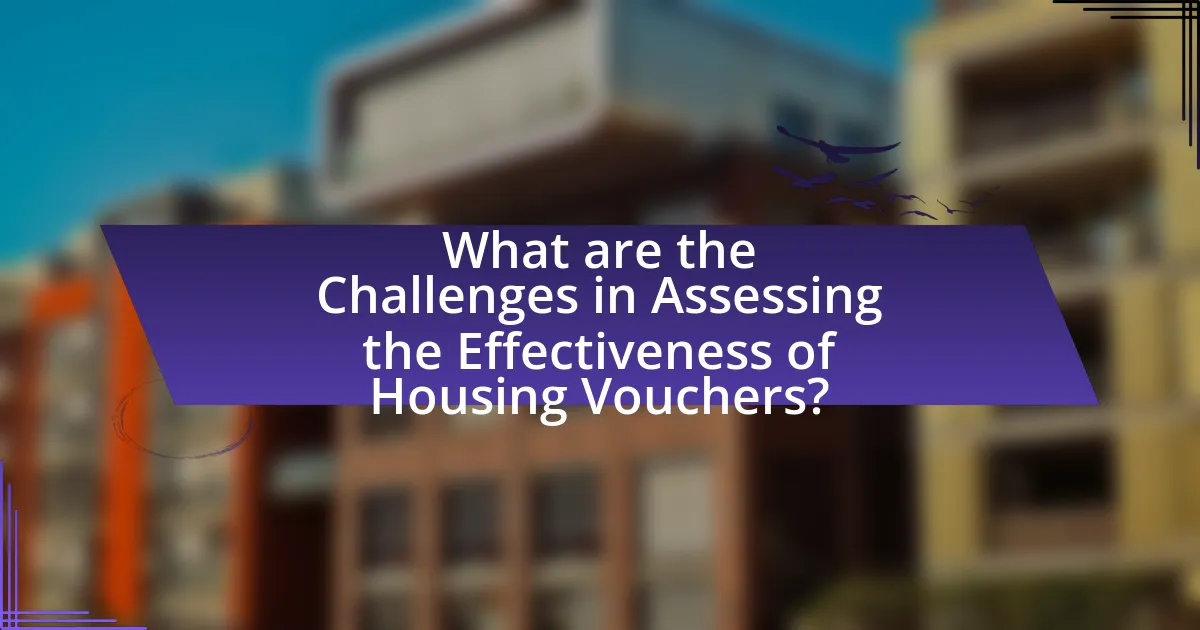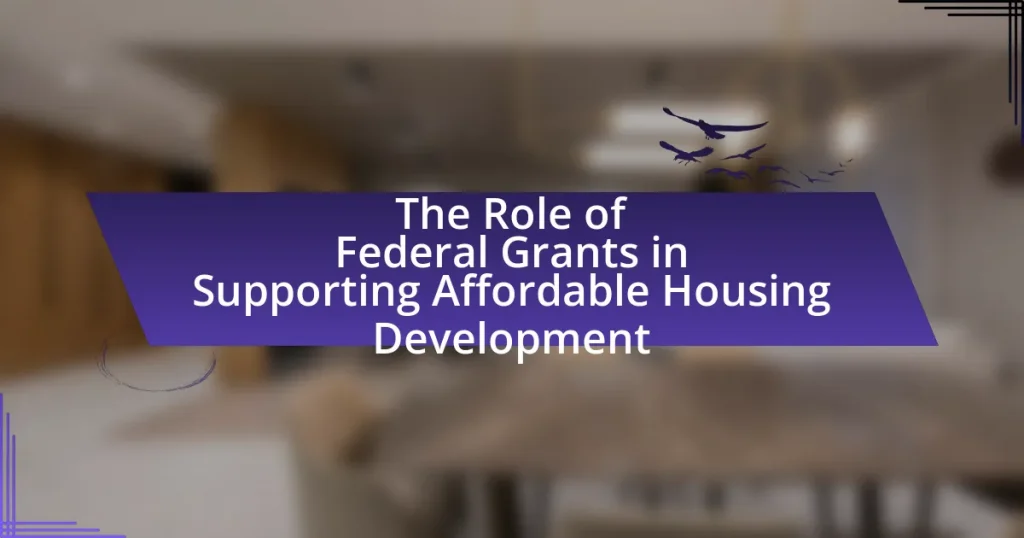Housing vouchers are government-issued subsidies designed to assist low-income individuals and families in affording housing in the private market, primarily through the Housing Choice Voucher Program. This article assesses the effectiveness of housing vouchers in financing affordable housing, exploring their purpose, functionality, and impact on the rental market. Key components of housing voucher programs, such as eligibility criteria and subsidy calculations, are examined alongside their influence on housing stability, community integration, and local economies. Additionally, the article addresses challenges in evaluating the effectiveness of these programs, including external factors and policy changes that affect implementation and outcomes.

What are Housing Vouchers and Their Purpose?
Housing vouchers are government-issued subsidies that assist low-income individuals and families in affording housing in the private market. Their primary purpose is to reduce the financial burden of rent, enabling recipients to secure stable housing while promoting economic mobility and integration into diverse communities. According to the U.S. Department of Housing and Urban Development (HUD), housing vouchers can cover a significant portion of rent, allowing families to spend no more than 30% of their income on housing costs. This program aims to alleviate homelessness and improve living conditions for vulnerable populations.
How do Housing Vouchers function in the context of affordable housing?
Housing vouchers function as a financial assistance tool that enables low-income individuals and families to afford housing in the private market. These vouchers, primarily administered through the Housing Choice Voucher Program, provide recipients with a subsidy that covers a portion of their rent, allowing them to choose housing that meets their needs while ensuring that they do not pay more than 30% of their income on housing costs. According to the U.S. Department of Housing and Urban Development, over 2.3 million households benefit from housing vouchers, which play a critical role in reducing homelessness and improving housing stability for vulnerable populations.
What are the key components of Housing Voucher programs?
The key components of Housing Voucher programs include eligibility criteria, subsidy calculation, tenant and landlord participation, and program administration. Eligibility criteria determine who can receive vouchers, typically based on income levels and family size, ensuring assistance reaches those in need. Subsidy calculation involves determining the amount of financial assistance provided to tenants, often based on a percentage of their income and local housing costs. Tenant and landlord participation is crucial, as tenants must find suitable housing that meets program standards, while landlords must agree to accept vouchers. Program administration encompasses the management and oversight of the voucher system, ensuring compliance with regulations and effective service delivery. These components collectively aim to provide affordable housing options and improve housing stability for low-income families.
How do Housing Vouchers impact the rental market?
Housing vouchers significantly impact the rental market by increasing demand for rental units, particularly in areas with higher-quality housing. When low-income households receive housing vouchers, they can afford to rent in neighborhoods that may have previously been out of reach, leading to a rise in rental prices in those areas. A study by the Urban Institute found that housing vouchers can lead to a 10% increase in rents in neighborhoods where voucher holders move, as landlords adjust prices based on the increased purchasing power of tenants. This shift can also contribute to gentrification, as the influx of voucher holders may attract higher-income residents and investment, further altering the rental landscape.
Why are Housing Vouchers considered a tool for financing affordable housing?
Housing vouchers are considered a tool for financing affordable housing because they provide financial assistance to low-income households, enabling them to afford rent in the private market. By subsidizing a portion of the rent, housing vouchers increase the purchasing power of these households, allowing them to access housing options that would otherwise be unaffordable. According to the U.S. Department of Housing and Urban Development, the Housing Choice Voucher Program has helped millions of families secure stable housing, demonstrating its effectiveness in bridging the gap between income and housing costs.
What are the financial implications of using Housing Vouchers?
Housing vouchers provide financial assistance to low-income families, enabling them to afford housing in the private market. This system reduces the burden of housing costs on these families, as the government subsidizes a portion of their rent, typically covering the difference between 30% of their income and the market rent. According to the U.S. Department of Housing and Urban Development, housing vouchers can lead to improved housing stability and reduced homelessness, which in turn can lower public spending on emergency services and healthcare. Additionally, studies indicate that every dollar spent on housing vouchers can generate significant economic activity, as families have more disposable income to spend on other necessities.
How do Housing Vouchers support low-income families?
Housing vouchers support low-income families by providing financial assistance that enables them to afford housing in the private market. These vouchers, such as the Section 8 program, cover a portion of the rent, allowing families to pay only a percentage of their income towards housing costs. According to the U.S. Department of Housing and Urban Development, families with housing vouchers can access better neighborhoods, which often leads to improved educational and employment opportunities. This financial support not only alleviates the burden of housing costs but also promotes stability and reduces homelessness among low-income households.

What are the Challenges in Assessing the Effectiveness of Housing Vouchers?
Assessing the effectiveness of housing vouchers faces several challenges, primarily due to the complexity of measuring outcomes and the variability in individual circumstances. One significant challenge is the difficulty in isolating the impact of housing vouchers from other factors that influence housing stability and economic mobility, such as local economic conditions and personal circumstances. Additionally, data limitations hinder comprehensive evaluations; many studies rely on self-reported data, which can be biased or incomplete. Furthermore, the diversity of housing markets across different regions complicates the generalization of findings, as the effectiveness of vouchers can vary widely based on local housing supply and demand dynamics. Lastly, the transient nature of voucher recipients can lead to challenges in long-term tracking and assessment of outcomes, making it hard to determine sustained effectiveness over time.
What metrics are used to evaluate the effectiveness of Housing Vouchers?
Metrics used to evaluate the effectiveness of Housing Vouchers include housing stability, affordability, and tenant mobility. Housing stability is measured by the duration tenants remain in their housing without experiencing eviction or homelessness, indicating the program’s success in providing secure living conditions. Affordability is assessed by the percentage of income that households spend on housing costs, with lower percentages reflecting better outcomes for families. Tenant mobility is evaluated through the ability of voucher holders to move to neighborhoods with better opportunities, which can be quantified by tracking relocation patterns and changes in neighborhood characteristics. These metrics collectively provide a comprehensive view of how effectively Housing Vouchers meet their intended goals.
How do these metrics reflect the success of Housing Voucher programs?
Metrics such as housing stability, increased rental affordability, and reduced homelessness rates reflect the success of Housing Voucher programs. These metrics indicate that participants are able to secure stable housing, as evidenced by studies showing that families using vouchers experience lower eviction rates compared to those without assistance. Additionally, the U.S. Department of Housing and Urban Development reports that voucher holders typically spend less than 30% of their income on housing, which aligns with the affordability goal of these programs. Furthermore, research from the Urban Institute highlights that areas with higher voucher utilization see a decrease in homelessness, demonstrating the program’s effectiveness in providing essential support to vulnerable populations.
What limitations exist in current evaluation methods?
Current evaluation methods for assessing the effectiveness of housing vouchers in financing affordable housing have several limitations, including a lack of comprehensive data, insufficient longitudinal studies, and challenges in measuring long-term outcomes. The absence of comprehensive data often leads to incomplete assessments, as many evaluations rely on self-reported information from participants, which can be biased. Additionally, insufficient longitudinal studies hinder the ability to track the long-term impacts of housing vouchers on recipients’ economic stability and housing quality. Challenges in measuring long-term outcomes arise from the difficulty in isolating the effects of housing vouchers from other socioeconomic factors, making it hard to determine their true effectiveness. These limitations highlight the need for more robust evaluation frameworks that incorporate diverse data sources and methodologies.
How do external factors influence the effectiveness of Housing Vouchers?
External factors significantly influence the effectiveness of Housing Vouchers by impacting housing market dynamics, availability of affordable units, and local economic conditions. For instance, high demand for rental properties in urban areas can lead to increased rents, making it difficult for voucher holders to find suitable housing within their budget. Additionally, local policies and zoning regulations can restrict the development of affordable housing, further limiting options for voucher recipients. Research by the Urban Institute indicates that areas with more inclusive zoning laws and higher rates of affordable housing development see better outcomes for Housing Voucher recipients, as they have access to a wider range of housing options. Furthermore, economic factors such as unemployment rates and income levels in a community can affect the overall housing market, thereby influencing the success of Housing Voucher programs.
What role do local housing markets play in the success of Housing Vouchers?
Local housing markets significantly influence the success of Housing Vouchers by determining the availability and affordability of rental units. When housing markets are tight, with limited affordable options, voucher holders may struggle to find suitable housing, leading to lower utilization rates of the vouchers. For instance, a study by the Urban Institute found that in high-demand areas, only 30% of voucher holders successfully secure housing, compared to 70% in more affordable markets. This disparity highlights how local market conditions directly impact the effectiveness of Housing Vouchers in providing access to affordable housing.
How do policy changes affect the implementation of Housing Vouchers?
Policy changes significantly impact the implementation of Housing Vouchers by altering funding levels, eligibility criteria, and administrative processes. For instance, when federal or state governments increase funding for housing assistance programs, more vouchers can be issued, allowing a greater number of low-income families to access affordable housing. Conversely, budget cuts can lead to reduced availability of vouchers, limiting assistance to those in need. Additionally, changes in eligibility criteria, such as income limits or family composition requirements, can either expand or restrict access to these vouchers, directly affecting the number of households that benefit from the program. Historical data shows that the introduction of the Housing Choice Voucher Program in 1974 expanded housing options for low-income families, demonstrating how policy shifts can enhance or hinder the effectiveness of housing assistance initiatives.

What are the Outcomes of Housing Voucher Programs?
Housing voucher programs primarily result in increased housing stability and improved quality of life for low-income families. These programs enable participants to afford housing in better neighborhoods, which can lead to enhanced access to education and employment opportunities. Research indicates that families using housing vouchers experience lower rates of homelessness and housing insecurity. For instance, a study by the Urban Institute found that families with vouchers are 50% less likely to experience homelessness compared to those without. Additionally, housing vouchers have been linked to improved health outcomes, as stable housing contributes to better physical and mental health.
How do Housing Vouchers affect housing stability for recipients?
Housing vouchers significantly enhance housing stability for recipients by providing financial assistance that allows them to afford rent in the private market. Research indicates that households utilizing housing vouchers experience lower rates of homelessness and housing instability compared to those without such support. For instance, a study by the Urban Institute found that families with housing vouchers are 50% less likely to face eviction than those relying solely on their income. This financial support not only enables recipients to secure stable housing but also fosters better overall well-being, as stable housing is linked to improved health and educational outcomes.
What evidence exists regarding the long-term benefits of Housing Vouchers?
Evidence indicates that Housing Vouchers provide significant long-term benefits, including improved economic stability and better health outcomes for recipients. Studies, such as the Moving to Opportunity experiment, demonstrate that families using vouchers experience increased income and reduced poverty levels over time. Additionally, research published in the Journal of Policy Analysis and Management shows that children in voucher-assisted households have higher educational attainment and better overall health compared to those in public housing or without assistance. These findings underscore the effectiveness of Housing Vouchers in promoting long-term socioeconomic improvements for low-income families.
How do Housing Vouchers impact community integration?
Housing vouchers significantly enhance community integration by enabling low-income families to access housing in diverse neighborhoods. This access promotes social interactions across different socioeconomic groups, fostering a sense of belonging and community cohesion. Research indicates that families utilizing housing vouchers are more likely to move to areas with better schools, employment opportunities, and lower crime rates, which contributes to improved life outcomes. For instance, a study by the Urban Institute found that families with housing vouchers experienced increased neighborhood stability and social ties, which are crucial for community integration.
What are the economic implications of Housing Voucher programs?
Housing Voucher programs have significant economic implications, primarily by increasing access to affordable housing for low-income families. These programs stimulate local economies by injecting federal funds into housing markets, which can lead to increased demand for rental properties and potentially higher rents in some areas. According to the U.S. Department of Housing and Urban Development, every dollar spent on housing vouchers generates approximately $1.50 in economic activity, demonstrating their role in boosting local economies. Furthermore, housing vouchers can reduce homelessness and its associated costs, such as emergency services and healthcare, thereby alleviating financial burdens on local governments.
How do Housing Vouchers influence local economies?
Housing vouchers positively influence local economies by increasing consumer spending and stabilizing neighborhoods. When low-income families receive housing vouchers, they can afford to rent in better neighborhoods, which leads to increased demand for local goods and services. This demand stimulates local businesses, resulting in job creation and economic growth. A study by the Urban Institute found that neighborhoods with higher concentrations of voucher recipients experienced a 10% increase in retail sales, demonstrating the direct economic impact of housing vouchers on local markets.
What are the cost-benefit analyses of Housing Voucher programs?
Housing Voucher programs provide significant cost benefits by reducing homelessness and improving housing stability for low-income families. A study by the Urban Institute found that every dollar spent on housing vouchers generates approximately $1.46 in economic benefits, including reduced costs for emergency services and healthcare. Additionally, housing vouchers have been shown to improve educational outcomes for children and increase employment rates among adults, further contributing to long-term economic gains. The cost-effectiveness of these programs is evident in their ability to lower public expenditures on social services while enhancing the quality of life for participants.
What best practices can enhance the effectiveness of Housing Vouchers?
Best practices that can enhance the effectiveness of Housing Vouchers include increasing landlord participation, providing supportive services, and implementing mobility counseling. Increasing landlord participation can be achieved through outreach programs that educate landlords about the benefits of accepting vouchers, which can lead to a broader range of housing options for voucher holders. Providing supportive services, such as job training and financial literacy programs, helps voucher recipients maintain stable housing and improve their economic situation. Implementing mobility counseling assists families in understanding their housing choices and navigating the rental market, which can lead to better housing outcomes. Research indicates that programs incorporating these practices have shown improved housing stability and satisfaction among voucher recipients.
How can policymakers improve Housing Voucher program design?
Policymakers can improve Housing Voucher program design by increasing flexibility in voucher use and enhancing administrative efficiency. Allowing vouchers to be used for a wider range of housing options, including units in higher-opportunity neighborhoods, can help recipients access better living conditions and job opportunities. Additionally, streamlining the application and renewal processes can reduce bureaucratic delays, making it easier for families to secure and maintain housing. Research indicates that programs with simplified procedures lead to higher participation rates and better outcomes for low-income families, as evidenced by studies from the Urban Institute, which highlight the correlation between administrative efficiency and program effectiveness.
What strategies can be implemented to increase participation in Housing Voucher programs?
To increase participation in Housing Voucher programs, targeted outreach and education initiatives should be implemented. These strategies can include community workshops that inform potential participants about the benefits and application processes of the programs, as well as partnerships with local organizations to reach underserved populations. Research indicates that when communities are actively engaged and informed, participation rates can increase significantly; for instance, a study by the Urban Institute found that targeted outreach efforts led to a 30% increase in applications for housing assistance in specific demographics. Additionally, simplifying the application process and providing assistance with paperwork can further enhance participation, as evidenced by programs that have streamlined their procedures and reported higher enrollment rates.



